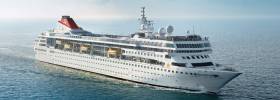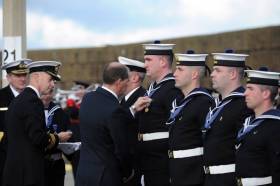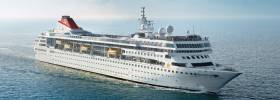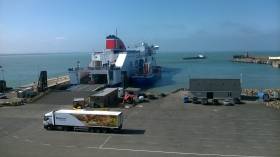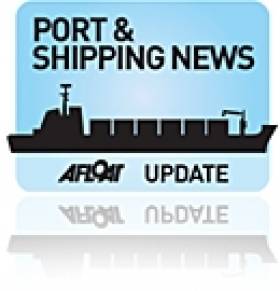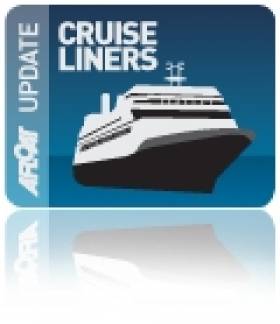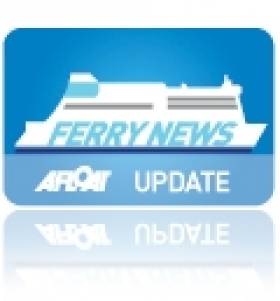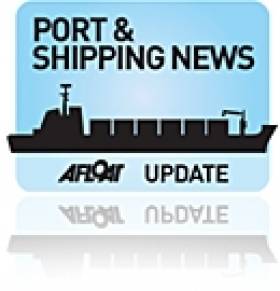Displaying items by tag: Rosslare Europort
Charges for Cruiseships Waived by Rosslare Europort
#ChargesWaived - Shipping lines have been notified by Rosslare Harbour that it is to waive charges for cruise ships for 2017, 2018 and 2019. The initiative is to establish the south-east as a destination for what is Europe’s fastest growing tourism sector.
This follows the success of the arrival of the Fred Olsen Lines’ MS Braemar in July of this year, which was the first cruise ship to call to Rosslare in 20 years. Feedback from cruise passengers and crew was excellent, from the ease of arrangements with the Europort to the programme of activities and the warm welcome from representatives of Wexford County Council and Fáilte Ireland, supported by Visit Wexford
John Lynch, General Manager Rosslare Europort said “up to 400,000 tourists visited Ireland on cruises this year, and it is a sector which continues to grow rapidly. Europe-wide, the cruise industry contributed over €40 billion to European economies, supporting 350,000 jobs.
“We believe – and customers from MS Braemar agreed – that Wexford and the South-East provide a destination which would be an excellent inclusion in any cruise itinerary visiting Ireland. By waiving charges, and working with local authority and tourism colleagues on the Working Group I established to develop new cruise business for the Europort, we are confident we can build a consistent and sustainable business which will bring tourists, profile and, crucially, employment and income to the South-East.
“We are fortunate at Rosslare that not only do we have the capacity to operate as a busy commercial port, but we are also situated in an area of outstanding natural beauty and rich cultural heritage and I believe that there will be many more Cruise Ships that will want to explore the wonders of Wexford and the South East.
“Our waiving of charges is a first step – we want to establish long-term relationships with the many cruise line companies operating in Europe which will support the Europort and the region into the future.”
Since 2008, European cruise capacity has grown by 44%, a trend which shows no sign of abating.
Customers on the MS Braemar had availed of pre-arranged excursions throughout the Wexford Region including scenic drives and walks, and visits to Tintern Abbey, Wells House, Kilmore Quay, the Irish National Heritage Park and the Dunbrody Famine Ship in New Ross.
Medal for Navy Service Personnel On Humanitarian Operations Abroad
#Medals - Personnel from Irish Defence Forces writes RTE, who have taken part in humanitarian operations abroad have been presented with a new medal in Rosslare Harbour.
Minister of State with special responsibility for Defence Paul Kehoe presented the new international operational service medals at a ceremony on Saturday (15 October) in the Co Wexford port.
Troops who were deployed to counter the Ebola crisis in Sierra Leone and naval personnel who helped rescue over 3,000 people in the Mediterranean last year received the award.
Among those receiving medals today were 54 members of the permanent Defence Force who served on board the Irish Naval Service flagship LÉ Eithne from May to July in 2015.
Also awarded the medal were five members of the Army personnel who served in Sierra Leone fight against Ebola.
This was the first of a number of similar ceremonies which will be held around the country.
#CruiseRosslare – Afloat in April reported on the planned visit of the first cruiseship to Rosslare in twenty years, this took place at the Co. Wexford ferryport this morning, writes Jehan Ashmore.
Rosslare Europort welcomed Fred Olsen Lines MS Braemar with 780 passengers and 380 crew which docked at around 06.30. Last year a similar sized capacity cruiseship, Albatross had to cancel an anchorage visit due to bad weather.
On this occasion, Braemar’s call is part of an 11-day “Closer to the UK and Ireland” cruise. The cruise began in Southampton and a scheduled itinerary included calls to Dundee, Lerwick, Fingal’s Cave, Invergordan. The cruiseship sailed overnight having called yesterday alongside to Liverpool Landing Stage.
Braemar’s cruise business to Rosslare Europort, operated by Irish Rail (Iarnród Éireann) will it be hoped the first of many to promote the ‘Model’ county as a destination and an area to visit.
The 24,344 tonnes Braemar docked within the harbour at the inner pier and on the adjacent berth was Irish Ferries Pembroke route ferry Isle of Inishmore. On the outer pier was Stena Line’s Fishguard route ferry, Stena Europe.
Cruise-goers will be exploring the Wexford region by taking pre-arranged excursions to Tintern Abbey, Wells House, Kilmore Quay, the Irish National Heritage Park and the Dunbrody Famine Emigrant Ship in New Ross.
At almost 196 metres in length, Braemar, lengthened in 2008, is the longest vessel to visit Rosslare ferryport from where both operators also have routes to France. Fred Olsen acquired the 1993 built Cunard Crown Dynasty originally 19,089 gross tonnage. Renamed Braemar, they inserted a 31 metre mid-section to boost capacity (729 cabins increased to 988) inclusion of a lounge and swimming pools.
The cruiseship’s call will for ferry fans will echoe memories of former French routes serving Saint Killian II, which too was stretched by just one metre more than Braemar. The ferry became 156m long compared to the much longer cruiseship.
Braemar presents a graceful slick appearance likewise of the ‘Killian’, albeit with a new livery applied this season of a half grey hull. This compared to the familiar previous all white scheme, so perhaps this latest look is not necessary the most appealing?
At 13,638 gross tonnage, the stretched Saint Killian II then in 1982 was the largest Irish-flagged ferry which served Irish Continental Line. She made a promotional once only call to Dun Laoghaire Harbour. For almost the next two decades she served a career to include Irish Ferries also out of Cork on routes to France (since closed).
On completion of Braemar’s visit today, this will have consolidated the work in the establishment of a Working Group led by Rosslare Europort’s General Manager John Lynch, representatives of Wexford County Council and Fáilte Ireland and supported by Visit Wexford.
Combined they have worked on developing the cruise business at Rosslare to target the further expansion of cruise ship business at the port.
Braemar’s only visit to an Irish port of this cruise will be followed by a final port of call to Falmouth.
#CruiseRosslare - Afloat’s tracking of known Irish Sea timber-trading cargoships recently led to Rosslare, synonymous for its ferries, is to welcome more business with a first cruise call in more than two decades, writes Jehan Ashmore.
In early July the honour of this inaugural cruise call will go to Fred Olsen Cruise Lines Braemar with more than 900 visiting passengers. The 24,344 tonnes vessel is to dock within the harbour and remain in port for up to 12 hours.
Last year Pheonix Reisen's similar capacity cruiseship Albatros which has a deeper draft was scheduled to anchor offshore. The call however was cancelled due to bad weather conditions preventing anchoring and tendering visitors ashore. To read more click here.
The call by Braemar this summer will be more keenly awaited by Rosslare Europort, where the harbour authority is unique for an Irish port in that it is operated by Irish Rail (Iarnród Éireann).
In addition the cruise call is to boost the season for businesses notably running visitor attractions in the ‘model’ county and that of Wexford town.
As reported previously on Afloat, Braemar took part in Fred Olsen's first ever fleet gathering to one port and all at the same time. The event took place in Bergen last year where the origins of Fred Olsen date back to 1848.
Since 1987 the operator have concentrated cruises departing from UK ports, through Southampton, Liverpool, Newcastle, Dover, Tilbury, Harwich and Falmouth.
Cargoships at Rosslare As Timber Trade Set for Further Growth
#CargoRosslare – A pair of cargoships loaded with timber in Scotland docked at Rosslare Europort, where the outlook in this trade in 2016 is for further growth at the Wexford ferryport, writes Jehan Ashmore.
Cargoship, Ayress (1979/1,713grt) loaded in Ayr on the Forth of CLyde with round timber (i.e. logs) that was discharged yesterday at Rosslare. Following that call, the Islay Trader (1992/2,386grt) loaded with cargo from Campbeltown on the Mull of Kintyre was also unloaded at the Irish port.
The timber trade began slowly in 2013/2014, but in 2015 about 20,000 tonnes of logs were imported through Rosslare using 12 shipments. Typical loading trading ports are from Scottish west coast ports, mainly Ardrishaig and Sandbank, with the occasional shipment from Campbeltown.
Both short-sea coasters berthed at Fisherman’s Quay which is the westernmost of the quays, leaving the other two piers dedicated to ferry traffic serving Wales and France. Irish Ferries operate to Pembroke, Cherbourg and Roscoff and Stena Line to Fishguard and also to Cherbourg.
The south-eastern port is also to welcome business from the cruise industry, in which Afloat will have more in an update this weekend.
Rosslare Appoint Consultants Over Port Concession Operation
#RosslareConsultants- Rosslare Europort (operated by Iarnród Éireann) has appointed consultants to assist in the process of assessing market interest in, and evaluating opportunities from, a concession structure for the operation of the port.
Following a procurement process through the Official Journal of the European Union, Rebel - a Rotterdam based firm of specialist shipping & port consultants who formed a consortium with DKM Economic Consultants and STS International a Wexford based firm of specialist RoRo shipping consultants – have been appointed to lead the process and advise Europort management.
This follows a study by Indecon Consultants for the Department of Transport, Tourism & Sport which examined strategic options for the future of the Europort, to maximise its potential and address future investment requirements. The report recommended that the Europort remain in the ownership of Iarnród Éireann, but with a long term concession with a third party.
The market consultation process being undertaken by Rebel on behalf of Rosslare Europort will assess interest and evaluate opportunities from a concession structure, including investment options for the future development of the Europort, which the concession proposal is designed to support.
Rosslare Europort is Ireland’s second busiest in terms of ship visits, unitised freight and passenger numbers, and is designated as one of only five ports of national significance in the National Ports Policy. The Port has recorded volume growth (freight and trade cars combined) of 7.1% in 2015 to date, on top of 5.5% growth in 2014.
Investors Sought to Upgrade Rosslare Europort
#RosslarePort - The Wexford People writes that up to €40 million is sought from investors to commit in a major upgrade of Rosslare Europort that will equip it to handle the ships of the future.
Iarnród Éireann, the Port Authority for Rosslare Europort, announced to port staff last week that it is to undertake an assessment of market interest in a concession with a third party to operate the Port.
The assessment follows a study by Indecon Consultants for the Department of Transport, Tourism & Sport which examined strategic options for the future of the Europort, to maximise its potential and address future investment requirements.
The report recommended that the Europort remain in the ownership of Iarnród Éireann, but with a long term concession with a third party.
Iarnród Éireann briefed all 73 employees at the port and will now commence the process of consulting with the market to assess interest and evaluate opportunities from a concession structure, which would be commonplace in ports in the EU and beyond.
Rosslare Europort is Ireland's second busiest in terms of ship visits and unitised freight, and is designated as one of only five ports of national significance in the National Ports Policy.
The Port has recorded growth of four per cent in freight units in 2015 to date, on top of a two per cent growth in 2014.
For more on this story, click here.
More Cruise Ship Business For Rosslare Europort
#cruiseship – Rosslare Europort is to see more cruise business in 2016 with the announcement that the Fred Olsen Lines cruise ship MS Braemar will visit on 16th July next year.
MS Braemar has 485 cabins with capacity for 929 guests, and will include Rosslare as part of a Britain and Ireland cruise.
This follows last year's announcement that the cruise ship MS Albatros, operated by Phoenix Reisen, will visit Rosslare Europort on 5th August 2015.
As previously reported on Afloat.ie, the call by Albatros will represent the first Cruise Ship to visit Rosslare Europort in over 20 years.
Both visits follow the establishment of a Working Group led by the General Manager Rosslare Europort John Lynch, including representatives of Wexford County Council and Fáilte Ireland and supported by Visit Wexford, which has been working on developing the cruise business at Rosslare. The group has targeted further expansion of cruise ship business at the port.
General Manager of Rosslare Europort John Lynch said: "We are delighted to welcome the MS Braemar to Rosslare in 2016, as well as the MS Albatros to Rosslare this summer. We are fortunate at Rosslare that not only do we have the capacity to operate as a busy commercial port, but we are also situated in an area of outstanding natural beauty and rich cultural heritage and I believe that there will be many more Cruise Ships that will want to explore the wonders of Wexford and the South East."
Sands to Shift So ‘Europort’ Ships Steer a Straight Setting
#RosslareDredging – Dredging operations to remove an unprecedented amount of sand at Rosslare Europort as previously reported, has highlighted the issue and some navigation restrictions in place at the ferryport that has routes linking to the UK and France, writes Jehan Ashmore.
The task to remove 100,000m3 of sand accumulated during a spate of severe winter storms earlier this year compares starkly to previous years where the average rate generated was only around 11,000m3.
Rosslare Europort, the port authority operated by Iarnród Éireann was allocated €1.4m to contract out the dredging works to restore normal working conditions following granting of a foreshore license.
Despite the dredging, ferries remain running albeit there are some navigational restrictions along the harbour's breakwater (outer pier) as the Dutch dredger Sospan Dau (1978/1,566 tonnes) is expected to take three weeks to complete operations.
The Europort has two clients, Stena Line, serving Fishguard in Wales and Cherbourg. The Normandy port is likewise linked by Irish Ferries which too has a second continental route to Roscoff, Brittany but only in the summer.
The sheer volume of sand that shifted alongside the breakwater will keep the Sospan Dau busy in removing and transferring the deposits to neighbouring Rosslare Strand, a popular scenic stretch along Wexford's sunny south-eastern shoreline.
Fishguard route vessel, Stena Europe (1981/24,828grt) which daily uses berth no. 3 at the Europort's breakwater, makes a wider swing off the breakwater where the affected area is marked off by a buoy. Other ferries less frequently using this same berth will also have to undertake this procedure as well to making a wider sweep off the pier-head's lighthouse.
Further along the breakwater, the shifting sands have led to the in-action of berth no. 4 though currently no ferries are running from this link-span lastly operated by fast-ferry Stena Lynx III. She was marketed as the Stena 'Express' sailing summer season sailings in tandem with the 'Europe'.
The fast-ferry was sold to South Korean interests as previously reported on Afloat.ie in 2011, leaving the conventional ferry to soldier on as the oldest in the ferry firm's Irish Sea fleet.
Despite the impact of the sand, the ferryport has additional berths at No. 1 and 2 located at the inner pier.
Should the occasion arise and not just because of sand related issues, ferries have the option to be re-allocated to these berths as long as the ships design and that of the link-span are compatible.
Dredger Starts Work to Remove 100,000m3 of Sand in Rosslare Europort
#RosslareDredging - Sospan Dau a Dutch dredger has recently started work in Rosslare Europort where as previously reported, sand of around 100,000m3 is to be removed from the breakwater, writes Jehan Ashmore.
The harbour's port authority in Rosslare Europort, Iarnród Éireann was allocated funding of €1.4m to contract out the works and is to take some three weeks to complete. Previous sand accumulation at the breakwater has normally been just 11,000m3.
The 1978 built Sospan Dau is transferring the dredged sand to an area just outside the low-water off Rosslare Strand. The sand is understood to be expected to be naturally carried ashore and replenish the beach.
The accumulated sand built up at the Wexford port arose due to severe storms within a fortnight during January and February. A buoy was positioned to mark off this restricted area, for photo click here.
Accompanying the 1,546 tonnes trailing suction hopper dredger is the Irish flagged workboat tug Trojan which has carried out many projects among them the construction of the new Kilronan Harbour on Inishmore, Aran Islands.


























